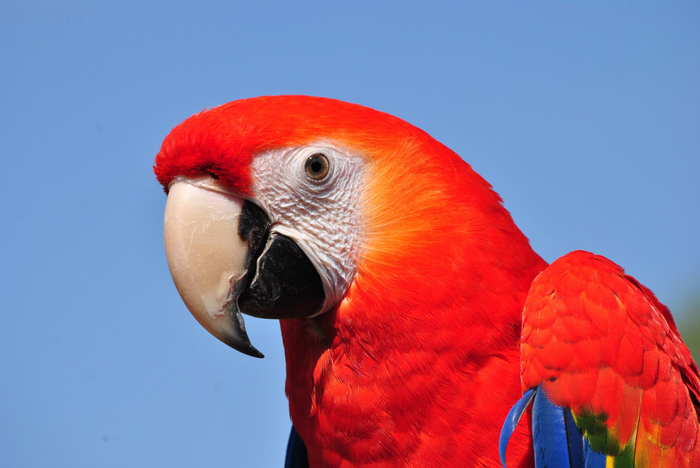Parrots are famous for their remarkable cognitive abilities and exceptionally long lifespans. Now, a study led by Max Planck researchers has shown that one of these traits has likely been caused by the other. By examining 217 parrot species, the researchers revealed that species such as the scarlet macaw and sulphur-crested cockatoo have extremely long average lifespans, of up to 30 years, which are usually seen only in large birds. Further, they demonstrated a possible cause for these long lifespans: large relative brain size. The study is the first to show a link between brain size and lifespan in parrots, suggesting that increased cognitive ability may have helped parrots to navigate threats in their environment and to enjoy longer lives.

Credit: Marlow Birdpark / Simon Bruslund
Parrots are famous for their remarkable cognitive abilities and exceptionally long lifespans. Now, a study led by Max Planck researchers has shown that one of these traits has likely been caused by the other. By examining 217 parrot species, the researchers revealed that species such as the scarlet macaw and sulphur-crested cockatoo have extremely long average lifespans, of up to 30 years, which are usually seen only in large birds. Further, they demonstrated a possible cause for these long lifespans: large relative brain size. The study is the first to show a link between brain size and lifespan in parrots, suggesting that increased cognitive ability may have helped parrots to navigate threats in their environment and to enjoy longer lives.
Despite the fact that parrots are well known for their long lives and complex cognition, with lifespans and relative brain size on par with primates, it remains unknown whether the two traits have influenced each other.
“The problem has been sourcing good quality data,” says Simeon Smeele, a doctoral student at the Max Planck Institute of Animal Behavior (MPI-AB) and lead author on the study, published in Proceedings of the Royal Society B. Understanding what has driven parrot longevity is only possible by comparing living parrots. “Comparative life-history studies require large sample sizes to provide certainty, because many processes are a play at once and this creates a lot of variation,” says Smeele.
To generate an adequate sample size, scientists from the MPI-AB and the Max Planck Institute for Evolutionary Anthropology (MPI-EvA) teamed up with Species360, which draws on animal records from zoos and aquaria. Together, they compiled data from over 130,000 individual parrots sourced from over 1000 zoos. This database allowed the team to gain the first reliable estimates of average life span of 217 parrot species—representing over half of all known species.
The analysis revealed an astonishing diversity in life expectancy, ranging from an average of two years for the fig parrot up to an average of 30 years for the scarlet macaw. Other long-lived species include the sulphur crested cockatoo from Australia, which lives on average 25 years.
“Living an average of 30 years is extremely rare in birds of this size,” says Smeele who worked closely with Lucy Aplin from MPI-AB and Mary Brooke McElreath from MPI-EvA on the study. “Some individuals have a maximum lifespan of over 80 years, which is a respectable age even for humans. These values are really spectacular if you consider that a human male weights about 100 times more.”
Next, the team employed a large-scale comparative analysis to determine whether or not parrots’ renowned cognitive abilities had any influence on their longevity. They examined two hypotheses: First, that having relatively larger brains enable longer lifespans. In other words, smarter birds can better solve problems in the wild, thus enjoying longer lives. Second, that relatively larger brains take longer to grow, and therefore require longer lifespans. For each species, they collected data on relative brain size, as well as average body weight and developmental variables.
They then combined the data and ran models for each hypothesis, looking at which model best explained the data. Their results provide the first support that increased brain size has enabled longer lifespans in parrots. Because brain size relative to body size can be an indicator for intelligence, the findings suggest that the parrots with relatively large brains had cognitive capabilities that allowed them to solve problems in the wild that could otherwise kill them, and this intelligence enabled them to live longer lives.
“This supports the idea that in general larger brains make species more flexible and allow them to live longer,” says Smeele. “For example, if they run out of their favourite food, they could learn to find something new and thus survive.”
The scientists are surprised that factors such as diet, or the greater developmental time required to develop larger brains, did not lead to longer average lifespans. “We would have expected the developmental path to play a more important role because in primates it is this developmental cost that explains the link between brain size and longevity,” says Smeele.
In the future, the team plan to explore if sociality and cultural learning in parrots might have also contributed to long lifespans. Says Smeele: “Large-brained birds might spend more time socially learning foraging techniques that have been around for multiple generations. This increased learning period could potentially also explain the longer life spans, as it takes more time but also makes the foraging repertoire more adaptive.”
“One thing that makes us humans special is the vast body of socially learned skills. We are really excited to see if long-lived parrots also have a ‘childhood’ in which they have to learn everything from finding and opening nuts to avoid upsetting the dominant male. Ultimately, we would like to understand which evolutionary drivers create a species with a life-history very similar to our ancestors.”
Journal
Proceedings of the Royal Society B Biological Sciences
DOI
10.1098/rspb.2021.2397
Method of Research
Meta-analysis
Article Title
Coevolution of relative brain size and life expectancy in parrots
Article Publication Date
23-Mar-2022




